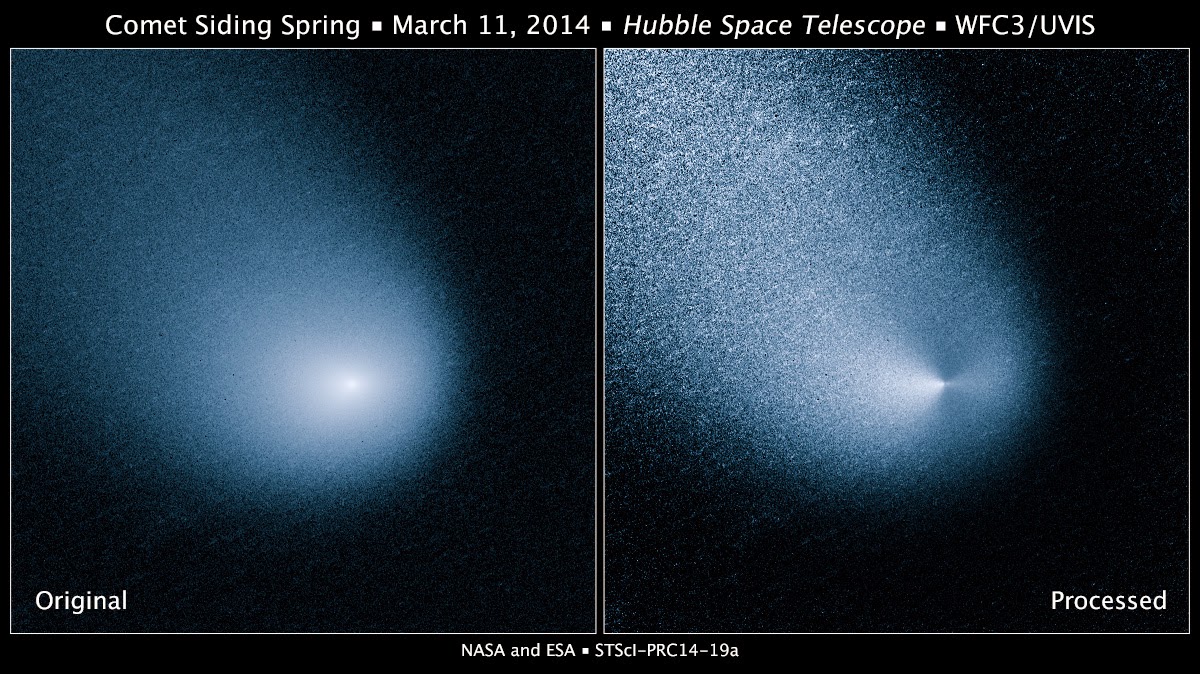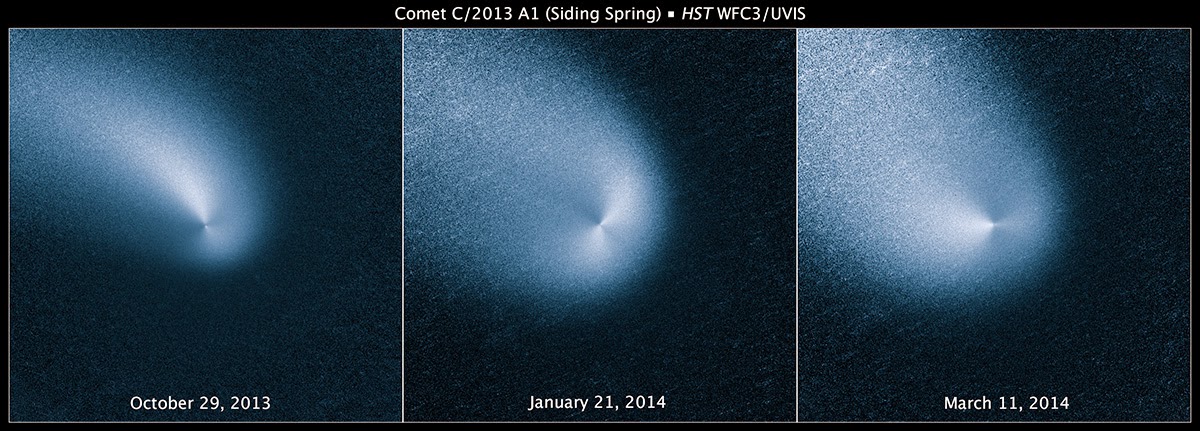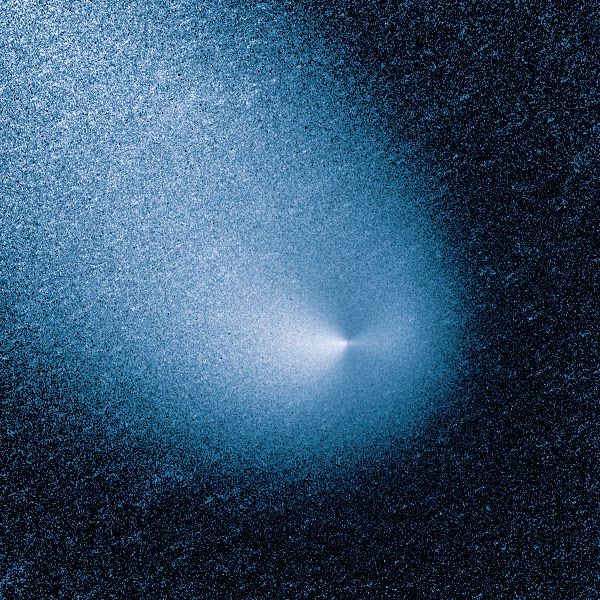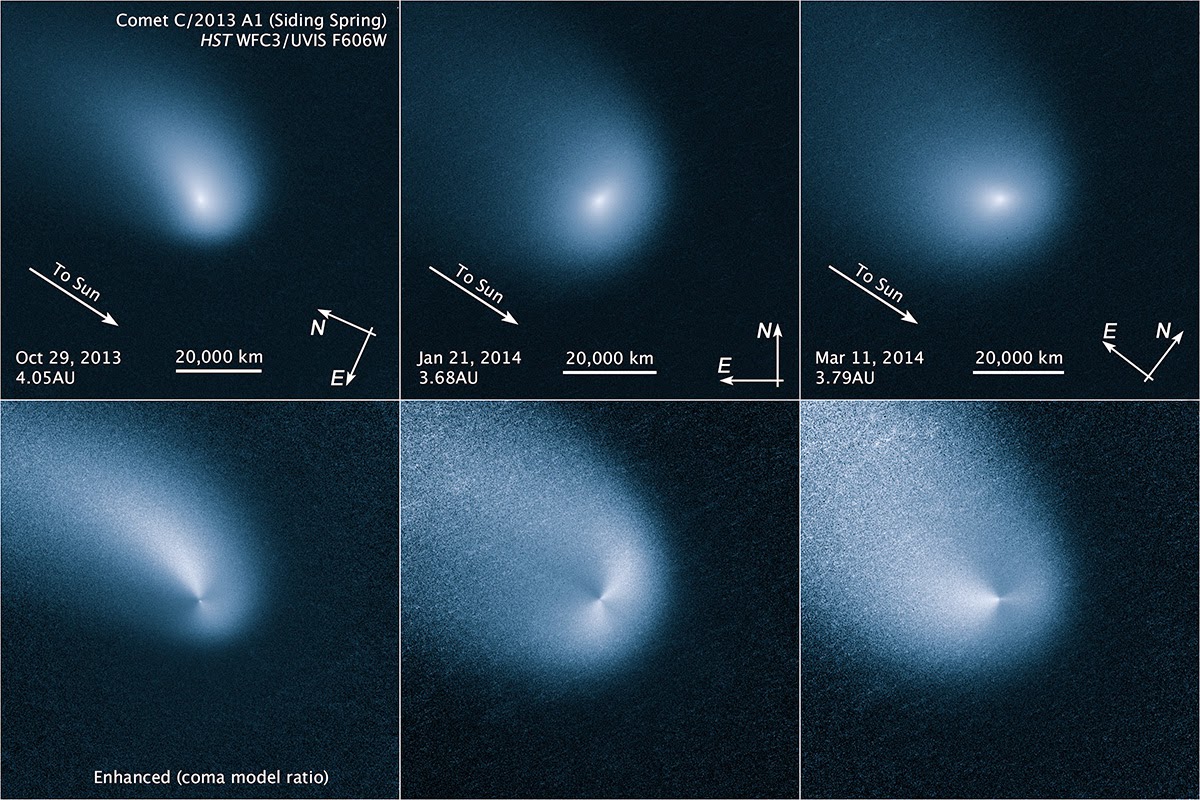Comet Siding Spring is plunging toward the Sun along a roughly 1-million-year orbit. The comet, discovered in 2013, was within the radius of Jupiter’s orbit when the Hubble Space Telescope photographed it on March 11, 2014. Hubble resolves two jets of dust coming from the solid icy nucleus.
Credit:
NASA,
ESA, and J.-Y. Li (Planetary Science Institute)
These persistent jets were first seen in Hubble pictures taken on Oct. 29, 2013. The feature should allow astronomers to measure the direction of the nucleus’s pole, and hence, rotation axis. The comet will make its closest approach to our Sun on Oct. 25, 2014, at a distance of 130 million miles, well outside Earth’s orbit.
On its inbound leg, Comet Siding Spring will pass within 84,000 miles of Mars on Oct. 19, 2014, which is less than half the Moon’s distance from Earth. The comet is not expected to become bright enough to be seen by the naked eye.
[Left] This is a Hubble Space Telescope picture of comet C/2013 A1 Siding Spring as observed on March 11, 2014. At that time the comet was 353 million miles from Earth. The solid icy nucleus is too small to be resolved by Hubble, but it lies at the center of a dust cloud, called a coma, that is roughly 12,000 miles across in this image.

Credit: NASA, ESA, and J.-Y. Li (Planetary Science Institute)
[Right] When the glow of the coma is subtracted through image processing, which incorporates a smooth model of the coma’s light distribution, Hubble resolves what appear to be two jets of dust coming off the nucleus in opposite directions. This means that only portions of the surface of the nucleus are presently active as they are warmed by sunlight, say researchers. These jets were first seen in Hubble pictures taken on Oct. 29, 2013. The feature should allow astronomers to measure the direction of the nucleus’s pole, and hence, rotation axis.
Discovered in January 2013 by Robert H. McNaught at Siding Spring Observatory in New South Wales, Australia, the comet is falling toward the Sun along a roughly 1-million-year orbit and is now within the radius of Jupiter’s orbit. The comet will make its closest approach to our Sun on Oct. 25, at a distance of 130 million miles — well outside Earth’s orbit. On its inbound leg, Comet Siding Spring will pass within 84,000 miles of Mars on Oct. 19, 2014 (less than half the Moon’s distance from Earth). The comet is not expected to become bright enough to be seen by the naked eye.
An earlier Hubble observation made on Jan. 21, 2014, caught the comet as Earth was crossing the comet’s orbital plane. This special geometry allows astronomers to better determine the speed of the dust coming off the nucleus. “This is critical information that we need to determine how likely and how much the dust grains in the coma will impact Mars and Mars spacecraft,” said Jian-Yang Li of the Planetary Science Institute in Tucson, Ariz.
This visible-light image was taken with Hubble’s Wide Field Camera 3.
Compass and Scale Image for Comet C/2013 A1 Siding Spring (3 Epochs)
Credit:
NASA,
ESA, and J.-Y. Li (Planetary Science Institute)
This is a series of Hubble Space Telescope pictures of comet C/2013 A1 Siding Spring as observed on Oct. 29, 2013; Jan. 21, 2014; and March 11, 2014. The distances from Earth were, respectively, 376 million miles, 343 million miles, and 353 million miles. The solid icy nucleus is too small to be resolved by Hubble, but it lies at the center of a dusty coma that is roughly 12,000 miles across in these images.

Credit: NASA, ESA, and J.-Y. Li (Planetary Science Institute)
When the glow of the coma is subtracted through image processing, which incorporates a smooth model of the coma’s light distribution, Hubble resolves what appear to be two jets of dust coming off the nucleus in opposite directions. The jets have persisted through the three Hubble visits, with their directions in the sky nearly unchanged. These visible-light images were taken with Hubble’s Wide Field Camera 3.








